To find the best business phone services, we spent weeks analyzing 544 customer-facing reviews across 23 criteria points as of 2026. We dug into real user sentiment, recurring pain points, support quality, and the day-to-day experience with setup, administration, reliability, integrations, AI capabilities (like call transcription and summaries), and pricing for each brand.
In the first round of research, we singled out 34 potential top brands. The next round whittled the number down to 29, and finally identified the top 9 business phone systems that best fit our criteria. That way, you’re not just getting vendor marketing claims—you’re seeing which platforms actually perform for real teams.
The Top 9 Best Business Phone Systems in 2026
Each of these brands stood out in the highly competitive business communications market for call quality, reliability, ease of use, and modern VoIP/UCaaS features. We review each one below after explaining our discovery process.
- Nextiva — Best business phone system for most companies
- RingCentral — Best for hybrid or remote work
- Vonage — Best for dispersed, omnichannel teams
- Ooma — Best for small businesses needing an easy setup
- Aircall – Best for brands with a consistently high call volume
- GoTo Connect – Best for getting a wealth of features in a basic plan
- Grasshopper – Best for solopreneurs and microbusinesses
- Talkroute – Best for small teams on-the-go
- 8×8 – Best for affordable, high-security calling services
For most of our readers, the best business phone system is Nextiva or RingCentral, thanks to their versatile range of features, dependable call quality, and strong customer support. If you care about modern AI tools like call summaries, live transcripts, and voicemail transcription, these two are also ahead of most competitors on higher tiers.
Vonage is feature-rich and globally friendly, but it typically runs a bit higher per line. And Ooma is a solid choice if you have a small business and want an exceptionally easy setup.
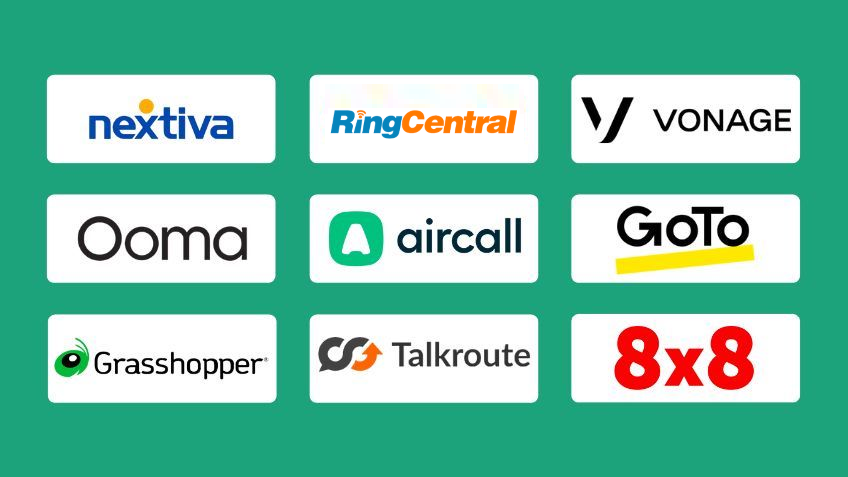
Match Your Scenario to the Right Business Phone Service
It can be difficult to figure out which business phone system brand will fit your company’s needs best. A busy medical practice has different needs than, say, a florist or mobile delivery service.
You may already know exactly what you need from a business phone service, but just in case you don’t, we have some resources for you. Here are five common scenarios that tend to drive the decision-making process when it comes to finding a business phone solution.
Use this list to help guide your decision, then jump down to the detailed reviews for the platforms that best match your situation.
- You need a complete phone system for team messaging, texting, video conferencing, and fax
- You need to manage a high volume of calls
- You don’t want to be tied to your desk
- You want to make calls primarily from your desk
- You want to add a business line to your cell phone
You Need a Complete Phone System for Team Messaging, Texting, Video Conferencing, and Fax
Best Option: Nextiva
Finding an all-in-one business phone system at a sensible price can be challenging—but not with Nextiva. Its current bundles deliver a complete UCaaS solution (voice, video, team chat, SMS/MMS, and fax) with straightforward administration, so you can go from signup to taking calls in minutes.
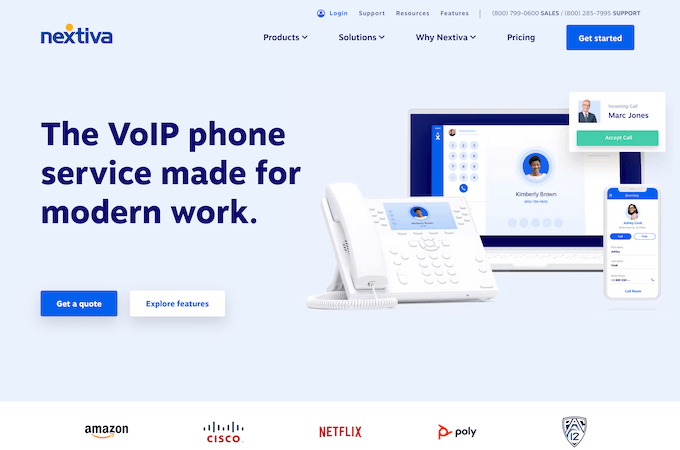
You’ll get the key UCaaS features you need, including:
- Unlimited conference calling
- Unlimited video meetings
- Team messaging
- Private group messaging
- Unlimited fax
- Mobile SMS/MMS
- Screen sharing
- Auto attendant
- Professionally recorded greetings
Nextiva supports large video meetings on upper-tier bundles and includes modern AI/automation (like conversational IVR, call summaries, and voicemail transcriptions on higher tiers). The AI tools are especially helpful if your reps live on the phones and need accurate notes without manual typing.
Overall, Nextiva is one of the most feature-packed phone systems on the market, and its call quality and reliability are consistently strong.
Another great choice: RingCentral
Like Nextiva, RingCentral delivers a complete UCaaS package that works for a wide range of businesses. On mid and upper tiers, you’ll get video meetings for large groups, SMS/MMS, fax, document sharing, team messaging, and robust AI features (like live transcripts, summaries, and coaching aids).
RingCentral also offers a webinar product, so marketing and customer-education teams can run branded events with registration, Q&A, polling, and analytics.
If you need a complete UCaaS system, consider these points when you’re making a decision:
- UCaaS depth: does the brand bundle calling, video, chat, and fax without costly add-ons for your hybrid or remote office?
- Voicemail extras: do you get transcription and recordings delivered where your team works?
- AI: are there time-savers like auto-attendants, summaries, real-time transcripts, and suggested actions?
- Admin ease: can non-technical admins add users, numbers, and routing in minutes?
You Need to Manage a High Volume of Calls
Best Option: Nextiva
If you constantly need to field thousands of outbound and inbound calls, Nextiva can easily handle your volume. With advanced call management, live dashboards, and historical analytics, Nextiva helps you connect with customers quickly and spot coaching opportunities on your team.
Nextiva also offers advanced IVR and conversational AI that routes callers to the right person or department based on intent—reducing transfers and wait time.

Another great choice: AirCall
Aircall shines for busy sales and support teams. You get call recording, warm transfer, IVR, skills- and time-based routing, and strong CRM integrations. Aircall now includes AI Assist for automated notes and summaries, and extended recording storage on higher tiers—handy for QA and coaching.
The advanced IVR alone handles the bulk of inbound flows without a live receptionist. Parallel calling lets one agent speak with two people at once. For outbound, the power dialer speeds up list-based outreach and syncs with your CRM.
If you’re looking for a business phone service specifically for its call center capabilities, pay attention to:
- Call management: forwarding, transfers, IVR, auto attendants, and smart routing outside business hours
- Analytics: queue health, SLAs, handle time, missed call rate, and agent performance
- Recording & transcription: for training, dispute resolution, and compliance
- Training tools: listen-in, whisper, and barge features for live coaching
- AI: summaries, QA assistance, and intent-based routing that reduce manual work
- Customization: white labeling or custom hold music and prompts
- Quality & reliability: SLAs, global PoPs, and failover strategy
- Unlimited calling: what’s truly unlimited, and what happens after fair-use thresholds?
- Outbound features: click-to-call, auto/power dialing, and scheduled callbacks
- Security & compliance: HIPAA/CPNI where applicable, encryption, data residency, and certifications
- Call tracking: attribution to campaigns so you know what’s driving calls
You Don’t Want To Be Tied to Your Desk
Best Option: RingCentral
RingCentral’s desktop and mobile apps are fully featured and highly rated, so you can pick up work anywhere. Everything you can do on desktop—calling, team chat, SMS/MMS, fax, and video—you can do on your phone or tablet without missing a beat.
This makes remote work and travel simple, and you can move live calls between devices with a tap.
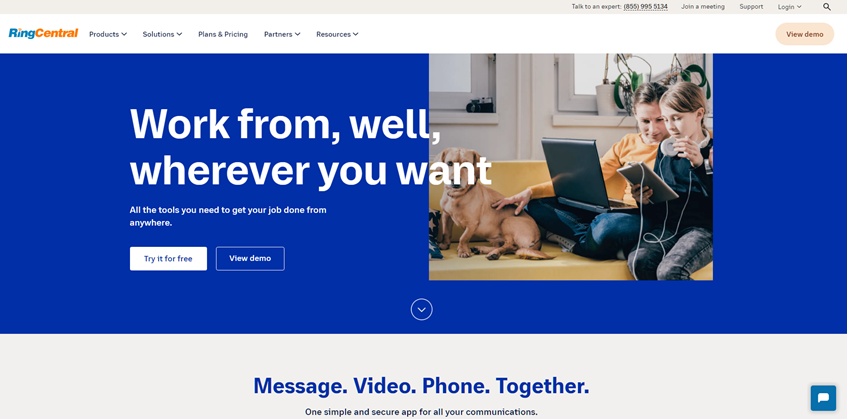
Beyond voice and text, RingCentral’s mobile app supports team chat and video conferencing. You can even send and receive online faxes from your smartphone.
You’ll get a consistent experience whether you’re on an office desktop, a home laptop, or a phone at the coffee shop.
You Want To Make Calls Primarily From Your Desk
Best Option: Ooma
Whether you need dedicated desk phones or prefer a softphone on your computer, Ooma fits right in. It works with many existing IP and analog phones, so you may not need to buy hardware at all. If you do, Ooma’s devices are plug-and-play—set up takes minutes.
Ooma is known for excellent reliability at the desk while staying budget-friendly and surprisingly full-featured.
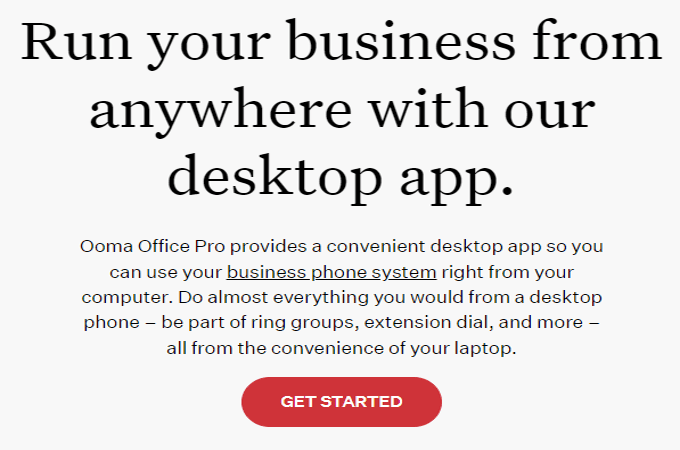
The Ooma Office Essentials plan includes a free mobile app, virtual receptionist, multi-ring, ring groups, call park, music on hold, call forwarding, virtual fax, call logs, and more—over 50 standard features designed for small businesses.
You Want To Add a Business Line to Your Cell Phone
Best Option: Talkroute
Add a toll-free, local, or vanity number to your mobile phone in the U.S. or Canada and run your business from anywhere. With Talkroute’s desktop, browser, and mobile apps, you can make and receive calls on whichever device you have handy.
Service is reliable anywhere your cell has service, and the mobile apps are well-rated on the App Store and Google Play.
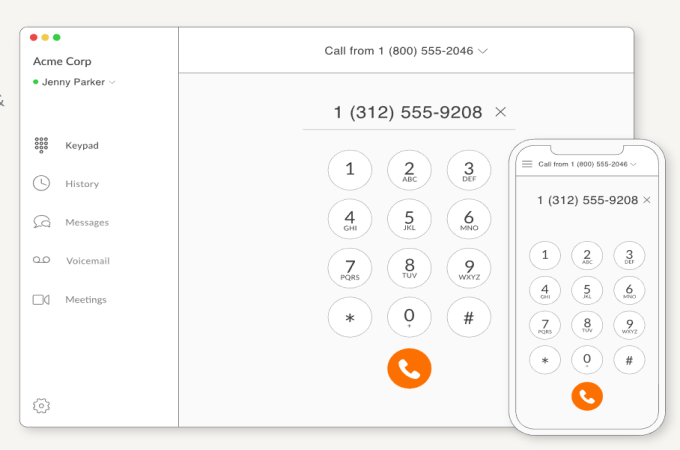
Once you install the app, you can set business hours, custom greetings, and menu options with extensions—so work stays on your terms even when everything runs from a single phone.
Another great option: Grasshopper
For solopreneurs or very small teams, Grasshopper is a simple way to keep your business number separate on the same device. You’ll get IVR, custom routing, warm transfers, call blocking, and 24/7 support—and it’s obvious which line is ringing.
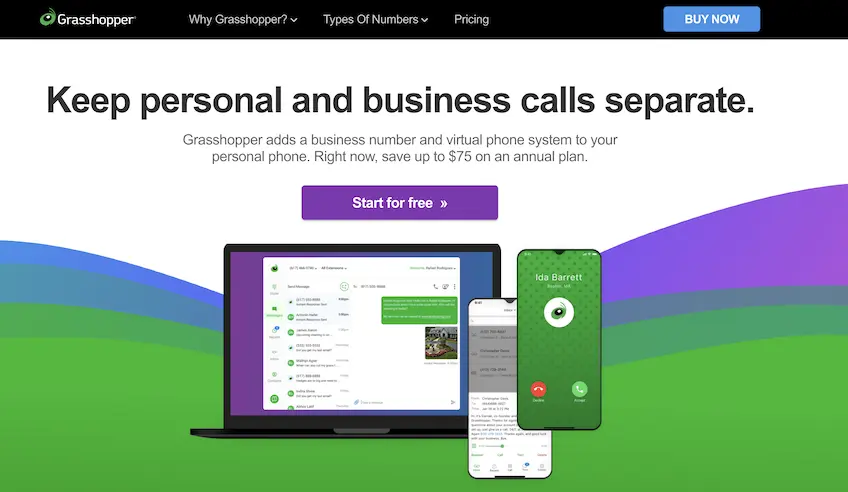
We also like Grasshopper’s scheduling controls for preserving work-life boundaries—keep your Sundays quiet without turning off your personal phone.
If you want to add a business line to your phone, pay attention to:
- Desktop & mobile apps: can you jump between devices—even mid-call?
- Quality & reliability: how does the system prevent dropped calls, echo, latency, and packet loss?
- Number options: can you choose local, toll-free, or vanity numbers without extra hoops?
- Voicemail: transcription, ample storage, and simple routing to the right inbox
The Best Business Phone System Reviews
Now that we’ve covered why we cut the brands we did and walked you through five key scenarios, it’s time to highlight the good stuff. In this section, you’ll discover why we loved these nine best business phone services. No matter what you need a business phone system for, we’re confident you’ll find an excellent match below.
Nextiva – Best business phone system for most companies
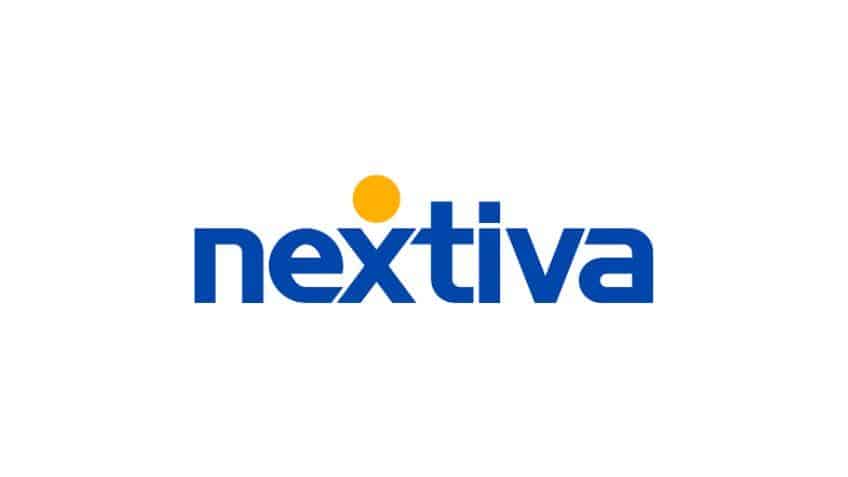
Nextiva is a great fit if you want a full-service UCaaS package covering the six core functions:
- Unified messaging
- Enterprise telephony
- Audio, video, and web conferencing
- Instant messaging and personal + team presence
- Mobility and communications-powered business processes
You’ll find these across Nextiva’s current bundles, with simple onboarding and an admin portal that’s friendly even for non-technical teams.
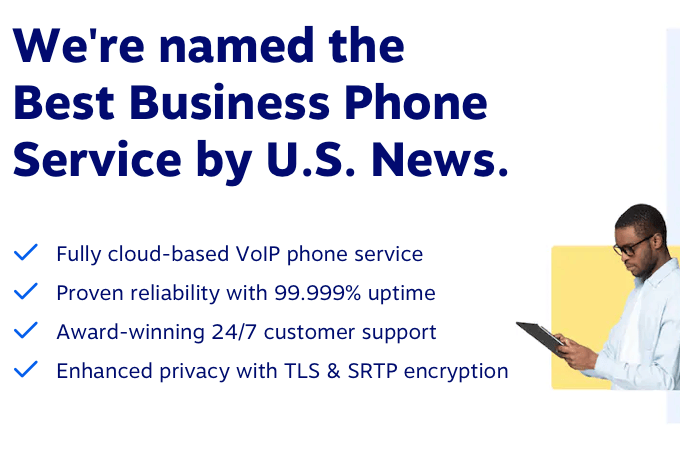
Trade-offs to note: some advanced capabilities—like full-length call/video recordings and voicemail transcriptions—are reserved for higher-tier bundles. And while the mobile apps have improved, a few users still prefer the desktop experience for heavy daily use.
What Makes Nextiva Great
We love that Nextiva goes beyond basics to elevate customer and agent experience. Highlights include:
- AI features like conversational IVR and auto-generated call notes/summaries
- Rich call management: multi-level auto attendants, advanced routing, caller ID, block/forward/transfer
- Actionable analytics for performance, conversion, and ad-driven call tracking
- Flexible implementation: port your number, use your own device, or get Nextiva-ready phones
Support is 24/7 and consistently praised for patience and helpfulness, which matters when phones are mission-critical.
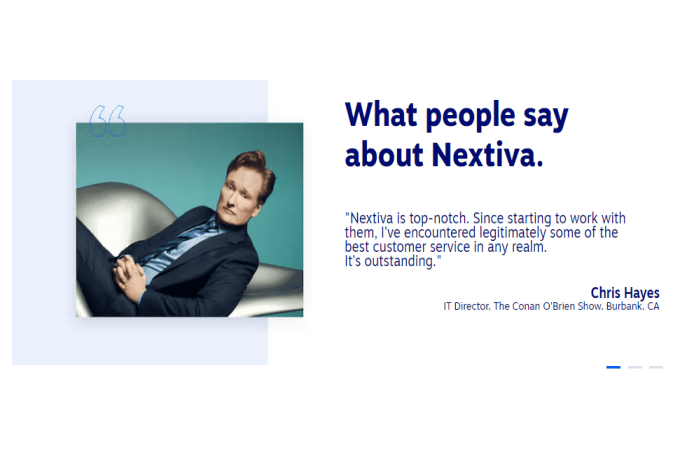
Here’s how pricing generally breaks down today:
- Core – Starts around the mid-teens per user/month with annual billing (volume discounts apply)
- Mid-tier bundle – Typically in the low-to-mid $20s per user/month annually; adds larger meetings and more integrations
- Upper-tier bundle – Generally in the low-$30s per user/month annually; unlocks full recording, advanced analytics, and expanded AI
Exact pricing depends on seat count and billing term. Month-to-month is available at a higher rate if you’re not ready for an annual commitment.
Get in touch with Nextiva today to get started with your business phone system. Find out more about Nextiva’s pricing plans here.
RingCentral – Best for Hybrid or Remote Work
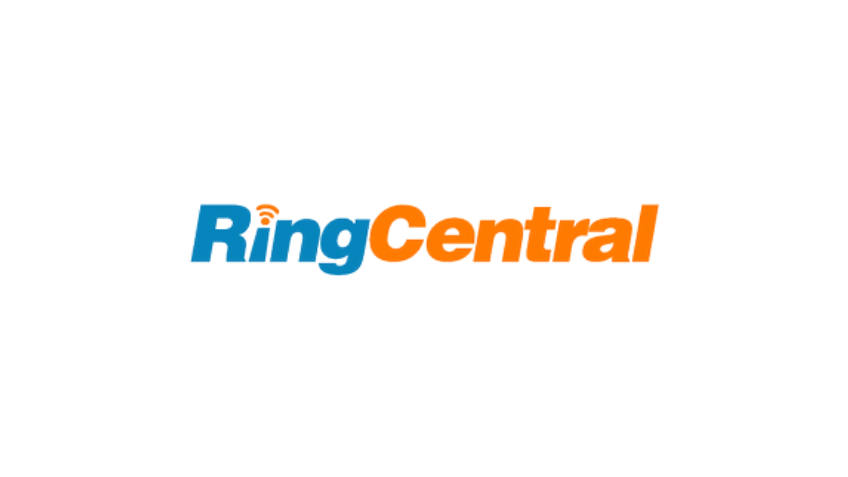
Need a phone system that’s equally good in the office and on the road? RingCentral delivers. Its iOS and Android apps earn high marks for reliability and depth, and the desktop experience is clean and intuitive.
RingCentral’s mid and top tiers bundle strong UCaaS tools, including:
- SMS/MMS
- Unlimited faxing
- Large video meetings
- Team messaging
- Document sharing
A common complaint is support responsiveness during peak times. While 24/7 phone and chat are included on higher tiers, some customers report longer wait times and too many transfers before resolution.
What Makes RingCentral Great
Customer service aside, RingCentral is quick to set up, admin-friendly, and packed with time-savers. Expect built-in analytics, IVR, 300+ integrations, versatile recording, and RingSense AI for live transcripts and summaries.
Other highlights:
- Real-time analytics
- Interactive voice response (IVR)
- One-click flip between softphone, desk phone, and mobile
- International calling options
- Contact center add-ons
- Incoming caller ID and call queues
- Breakout rooms, collaborative notes, and whiteboarding
Whatever you can do on desktop, you can do on mobile—ideal for on-the-go teams.
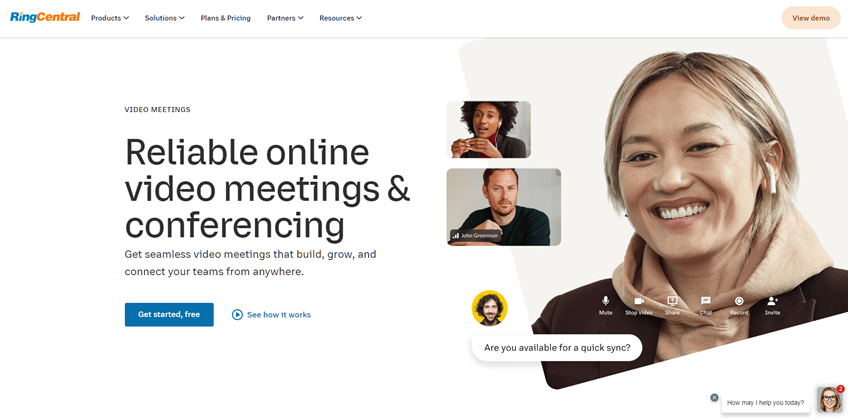
Plans and pricing:
- Core – $20 per user per month billed annually
- Advanced – $25 per user per month billed annually
- Ultra – $35 per user per month billed annually
Month-to-month rates start at $30, $35, and $45 per user per month, respectively.
You can test any RingCentral plan and get a free consultation.
Vonage — Best for Dispersed Teams
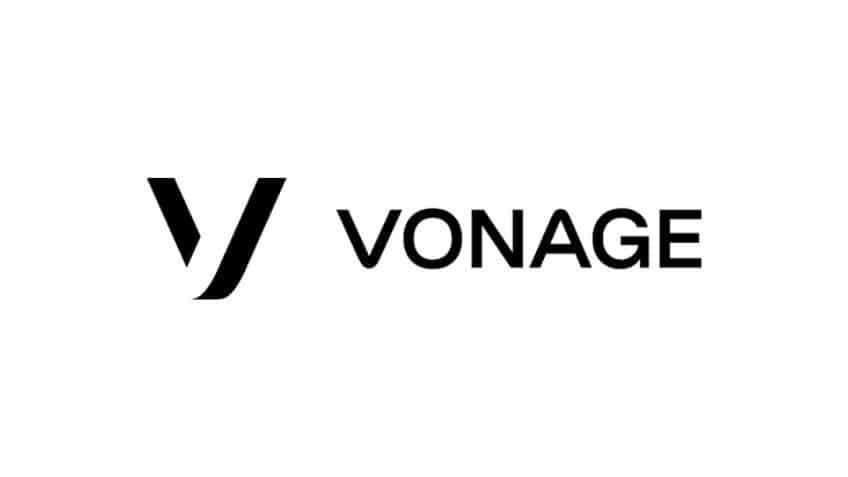
Vonage is a global calling solution that connects you with colleagues and customers on the channels they prefer, wherever they are. With desktop and mobile apps, support for desk phones, and video conferencing, distributed teams can collaborate from anywhere. Vonage also supports modern messaging via its APIs and tools—covering business SMS/MMS, RCS, and even Apple Messages for Business (iMessage) through its conversational commerce stack—so you can engage customers beyond voice when it counts.
What Makes Vonage Great
Vonage’s no-code AI Studio lets you drag-and-drop automations for voice and messaging. Its developer-friendly APIs make it easy to embed communications in your products and workflows.
Other standout features:
- Ecommerce integrations
- 99.9% uptime
- Tools to mitigate dropped connections
- Call automation sequences
- Monitoring and coaching tools
- Streamlined integrations and APIs
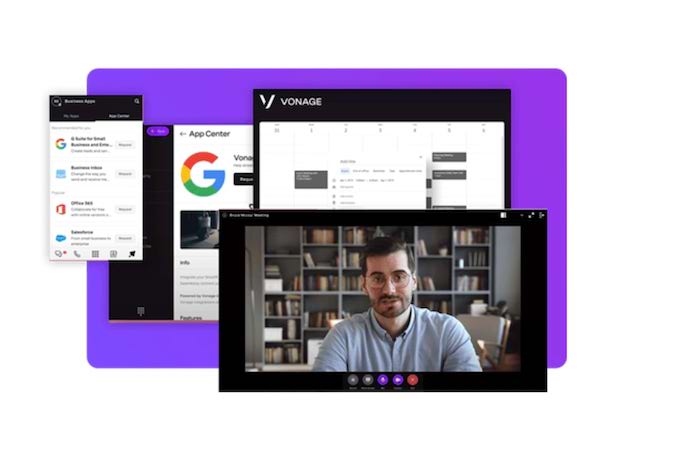
Vonage’s business communications plans typically start at $13.99 per line per month for Mobile (apps, unlimited calls/SMS, team messaging). Premium adds desk phones and CRM integrations from $20.99, and Advanced includes more automation and hardware options from $27.99 per line per month.
Ooma – Best for Small Businesses Needing an Easy Setup
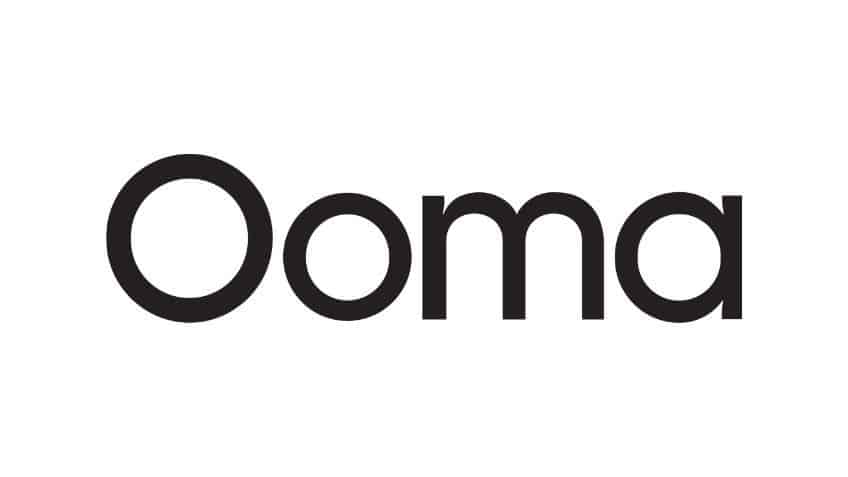
If setting up a business phone system sounds overwhelming, Ooma makes it painless. In just a few guided steps, you’ll configure users, your virtual receptionist, business hours, and any extras like toll-free numbers or number porting.
- Configure user accounts
- Decide how to handle incoming calls using the virtual assistant and incoming call menu
- Set your business hours
- Customize additional features, such as adding a toll-free number, number porting, and conference calling
Questions during setup? Ooma’s 24/7/365 support is responsive and well-reviewed. Ooma focuses on ease of use and day-one value rather than piling on advanced AI and outbound sales tooling—and that’s exactly what many small businesses want.
Note: Ooma’s full desktop app requires Pro or Pro Plus. Essentials users can still call and manage settings via mobile and web.
What Makes Ooma Great
For small teams, Ooma’s “just works” approach is ideal. You get clean, practical features that cover the bases without a learning curve, including:
- Music on hold and transfer music
- Call forwarding and ring groups
- Virtual receptionist and call park
- Extension dialing & monitoring
- Call logs and virtual fax
- Intercom and enhanced call blocking
- Call recording and voicemail transcription (on higher tiers)
It all adds up to a professional system that keeps you, your team, and your customers happy.
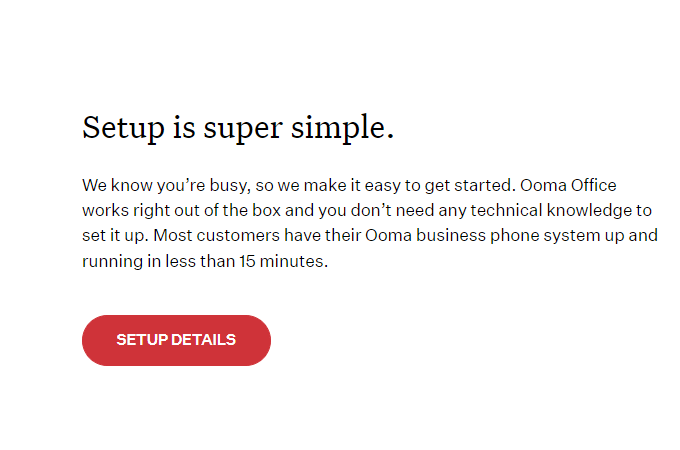
Ooma offers three plans packed with 50+ features and quick setup. Pricing starts at $19.95 per user per month (Essentials), with Pro and Pro Plus at $24.95 and $29.95. There are no long-term contracts, and plans include a 30-day money-back guarantee.
Aircall – Best for Brands With a Consistently High Call Volume
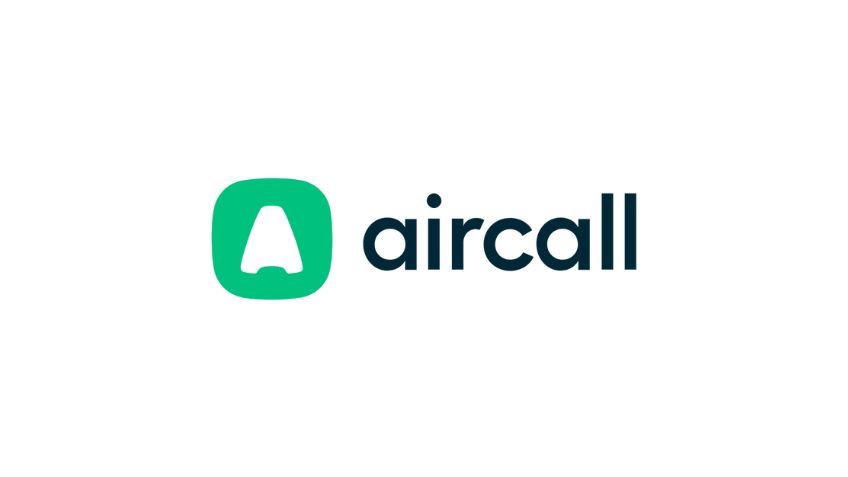
If your phones rarely stop ringing, Aircall keeps teams organized and responsive.
Key features for heavy call volume:
- Business hours: set unique hours per number
- IVR: guide callers to the right place fast
- Warm transfer: pass context with the call
- Routing: send calls to the most available or most skilled agent
- Queue callback: let callers hang up and keep their place
- Parallel calls: consult with a second person without dropping the first
- Block unwanted calls: stop spam before it hits your team
Call quality over VoIP can vary by network conditions. Most users report good quality, though some note occasional instability on international routes. Test with your locations before rolling out globally.
What Makes Aircall Great
Aircall’s analytics make coaching easier. Basics like average call time, wait time, and missed calls come standard. Higher tiers add a live feed, coaching tools, and advanced filtering for deeper insight. AI Assist now auto-summarizes calls and notes, saving reps time.
Upper plans also add:
- Queued callbacks
- Call monitoring and whisper
- Power dialer
- Dedicated account manager and personalized onboarding
- Unlimited access to recordings
Ecommerce and CRM integrations surface purchase history and context before you pick up—great for fast, personalized support.
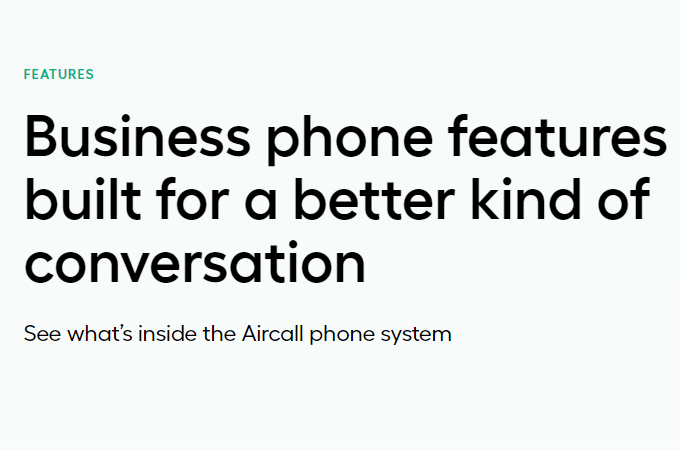
Pricing begins at $30/month billed annually for Essentials. Professional starts at $50/month, and larger orgs can request custom pricing. Try it with a seven-day free trial.
GoTo Connect – Best for Getting a Wealth of Features in a Basic Plan
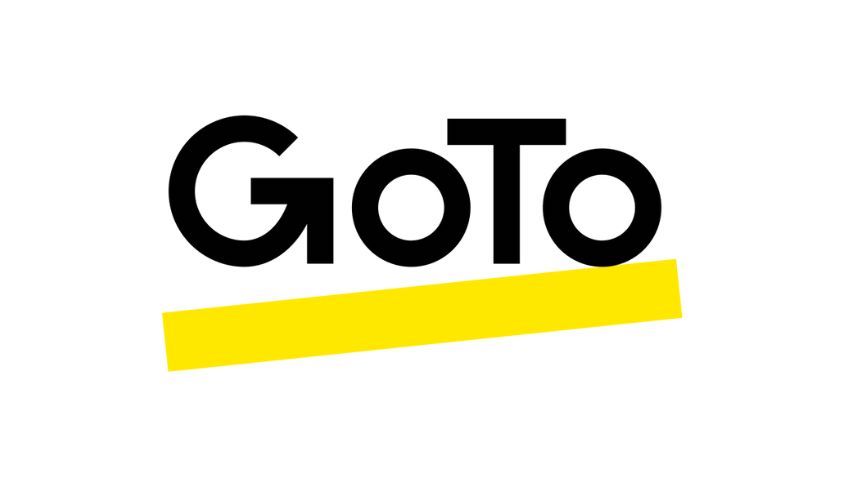
Want a base plan that doesn’t skimp? GoTo Connect packs in a ton of value, even before you upgrade.
On the Basic plan, you get:
- Local, toll-free, or vanity numbers
- Up to 20 users
- Video meetings for small groups
- Core integrations
- Multi-device calling
- Number porting
- Unlimited extensions
- Instant text response
- Call forwarding
- Team messaging
- Audio conferencing
- 40-minute meetings
Newer updates add smart notes in meetings, co-organizers, and popular whiteboard integrations at higher tiers. GoTo also includes AI GoPilot, free calling to 50+ countries, and 1,000 shared toll-free minutes on its broader phone system bundles.
Getting bigger? The Standard plan increases participant limits and international calling coverage, plus more admin and analytics tools.
What Makes GoTo Connect Great
GoTo Connect delivers a lot of core capability for the price—especially on Basic—and scales cleanly as you grow. If you step up, you’ll unlock generous international calling (to 50+ countries) and included toll-free minutes alongside advanced routing and admin controls.
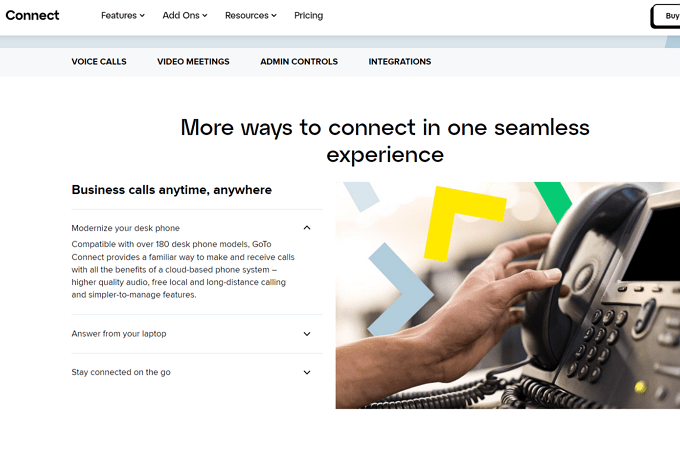
Note: GoTo Connect’s publicly listed rates vary by seat count and promotions. Expect quotes to reflect annual terms and the number of users you need, with Basic typically in the high-$20s and Standard in the low-$30s per user in many scenarios.
Grasshopper – Best for Solopreneurs and Microbusinesses
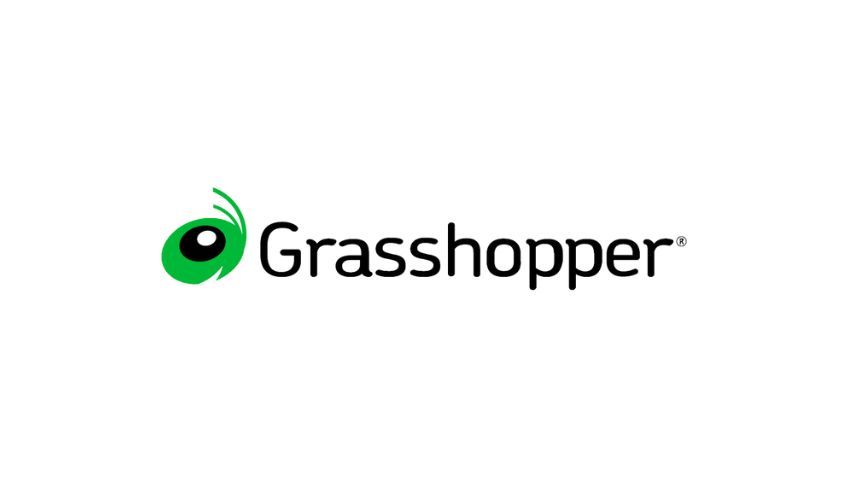
If you’re a sole proprietor or running a tiny team and don’t need all the bells and whistles, Grasshopper is a lightweight call-forwarding system that keeps business calls separate on your personal phone.
Heads-up: Grasshopper is intentionally lean. It doesn’t include deep integrations or advanced outbound dialing. And if you’re based in Alaska or Hawaii, a one-time deposit may apply due to carrier costs.
What Makes Grasshopper Great
Setup takes minutes. You can route calls by schedule, block callers, configure IVR, and use supervised or blind transfers. There’s also a third-party live-answering integration with Ruby if you want a virtual receptionist.
Upload your own hold music, record custom greetings, and view basic analytics. All plans include unlimited users, minutes, and texts.
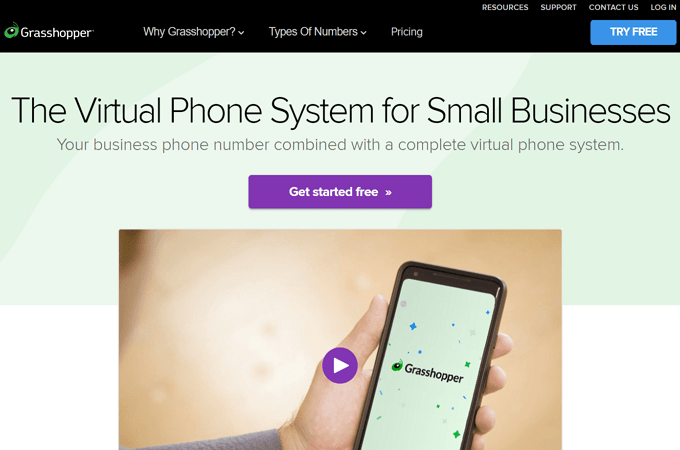
Plans start at $14/month billed annually (True Solo) and scale up with additional numbers and extensions on higher tiers. A seven-day free trial is available.
Talkroute – Best for Small Teams On-the-Go
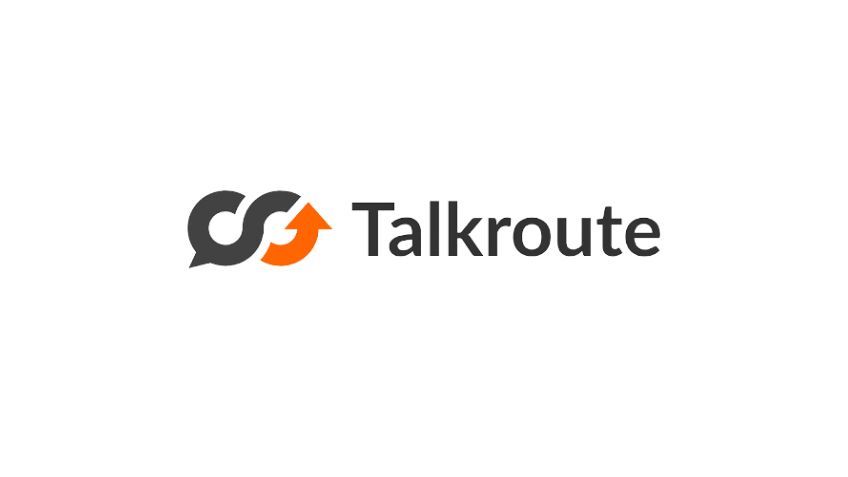
Need a simple, mobile-friendly business number without new hardware? Talkroute turns your existing phone and computer into a virtual phone system.
With plans starting at $19/month, you’ll get calling, texting, video meetings, forwarding, multi-digit extensions, and more.
Talkroute doesn’t chase AI bells and whistles, international calling, or deep integrations—and small teams usually won’t miss them. For healthcare orgs, Talkroute can support HIPAA compliance with BAAs on higher tiers; you may need to disable voicemail-to-email and avoid PHI in SMS to stay compliant.
What Makes Talkroute Great
Every plan includes unlimited calling. It’s easy to spin up a professional system without buying desk phones, and adding users is just $5/month.
Entry-level plans cover the essentials. Step up to get call recording with long-term retention, which is helpful when you’re constantly on the move and want to revisit conversations.
Advanced features on higher tiers include:
- Company directories
- Submenus
- Multi-digit extensions
- Call recordings
- Detailed call paths
Setup is quick. Talkroute rides your existing cell/landline network (PSTN). If you prefer white-glove help, book a 30–60 minute setup call.
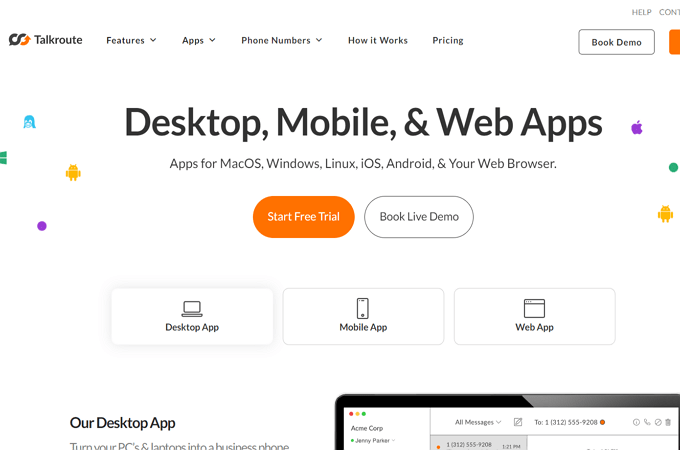
Talkroute Basic starts at $19 per month plus $5 per additional user. At $39/month, Plus delivers the best value for most. Pro, at $59/month, unlocks everything. Try any plan with a seven-day free trial.
8×8 – Best for Affordable, High-Security Calling Services
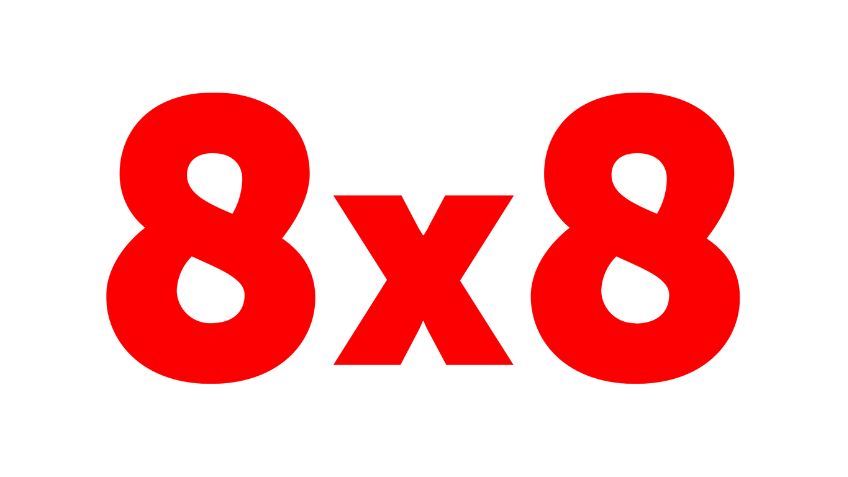
If you want straightforward, secure calling without overpaying, 8×8 is a strong contender.
Security is a core 8×8 focus with layered encryption, fraud detection, and a strong compliance posture (including ISO certifications and GDPR commitments). It also offers global reach and reliable uptime—key advantages if you support international teams.
Some advanced features (like auto-dialing and scheduled callbacks) live in the contact center product, but most businesses will find the base phone plans more than capable.
What Makes 8×8 Great
8×8 blends budget-friendly pricing with global coverage and strong security. Common U.S. plan names include Express, X2, and X4, with per-user rates that vary by term and seat count.

For exact pricing and bundles for your location, reach out to 8×8 for a tailored quote.
How to Budget for a Business Phone System (Pricing, TCO, and ROI)
Sticker prices rarely tell the whole story. Use this section to forecast the total cost of ownership (TCO) for your first year and make sure the plan you choose aligns with how your team actually communicates.
What Drives Your Real Cost
- Seats and roles: agent, supervisor, admin, and occasional users may need different tiers.
- Numbers: direct inward dials (DIDs), toll-free, vanity numbers, and seasonal lines all add up.
- Minutes and messaging: domestic vs. international calling, SMS/MMS volumes, and fair-use thresholds on “unlimited.”
- Advanced features: call recording retention, voicemail transcription, AI summaries, analytics, and contact center add-ons often live on higher tiers.
- Devices: reuse SIP phones, go softphone-only, or budget for new handsets and headsets.
- Compliance & security: HIPAA/CPNI needs, encryption, audit logs, and data residency can influence plan selection.
- Taxes & regulatory fees: E911, USF, and other pass-throughs typically appear on the invoice.
Build a One-Page TCO Estimate
- Seats: multiply users on each plan by the annual rate; include contractors or seasonal temps.
- Numbers: count main line, departmental lines, DIDs, and toll-free; add per-number monthly fees.
- Usage: forecast outbound minutes, international minutes, and SMS/MMS; add expected overages.
- Features: price add-ons like long-term recording storage, analytics packs, and webinar or contact center modules.
- Hardware: handsets, adapters, headsets, PoE switches; include one-time costs and expected replacements.
- Implementation: number porting, greeting/professional voiceovers, and optional white-glove setup.
- Contingency: add 10–15% for growth and incidentals so you aren’t surprised mid-year.
Quick example: 25 users on a mid-tier plan, 12 DIDs + 1 toll-free, basic recording, and modest SMS might total a few hundred dollars per month in licensing, plus numbers and taxes. Add one-time porting and a handful of headsets, and you have a realistic first-year view that’s far more accurate than headline pricing.
Ways to Lower Your Bill Without Sacrificing Quality
- Right-size tiers: put heavy callers and supervisors on higher plans; everyone else on core plans.
- Consolidate tools: replace separate fax, video, and team chat apps with a single UCaaS bundle.
- Reuse hardware: confirm SIP compatibility for existing phones or go software-only where practical.
- Optimize routing: smart IVR and queue callbacks reduce hold time and wasted minutes.
- Tighten retention: keep only the recording history you truly need; archive older files externally if policy allows.
- Negotiate: ask for volume/term discounts, pooled minutes, and a price-hold for year two.
Pro Tips for a Clean Rollout
- Set success metrics up front: missed call rate, average speed of answer, handle time, first-call resolution, and CSAT.
- Keep menus simple: two IVR layers max, clear “press 0” escape, and queue callback during spikes.
- Harden quality: prioritize voice traffic with QoS, reduce Wi-Fi congestion, and monitor jitter/packet loss the first week.
- Document the basics: transfers (blind vs. warm), parking, voicemail rules, and flipping calls between desktop and mobile.
With a realistic budget, clear KPIs, and a modest contingency, you’ll avoid surprise fees and deploy a system that improves customer experience and team productivity from day one.
Frequently Asked Questions
What should I look for in a small business phone system?
The first thing to look for in a small business phone system is call quality and uptime rates. A robust suite of features is useless if calls are constantly dropping or the audio echoes. You should always try to test a business phone system to ensure its compatibility with your network before locking in a contract. Beyond quality and reliability, look for features that you want or need to communicate. Examples include video conferencing, team messaging, fax, call recording, virtual receptionist, call forwarding, overhead paging, and more. Increasingly, small businesses also benefit from built-in AI tools like live transcripts, call summaries, and voicemail transcription. Then find a plan within your budget that includes all of those features.
What are the different types of business phone systems?
The three most common types of business phone systems are VoIP, PBX, and KSU. These variations can be deployed in the cloud as a hosted service or on-premises as a non-hosted solution. VoIP phones have become a favorite for businesses seeking a modern phone system with a versatile communication suite, especially when bundled as a full UCaaS platform (voice, video, messaging, and fax in one place).
What is the easiest way to get a business phone number?
Ooma is the easiest way to get a business phone number. When you sign up, it’s easy to select a local or toll-free number. You also have the option to port over your existing number if you want to keep it. Since there’s no hardware required to use Ooma, you can start making and receiving calls on your new business phone number right away through Ooma’s intuitive desktop and mobile apps.
What’s the difference between business and residential phone systems?
The biggest difference between business and residential phone systems is the features. Business phone systems have more capabilities than phones designed for home use. Both phone systems will support basic features like caller ID, voicemail, and call waiting. But business phones typically include call forwarding, cloud recording, hold music, virtual receptionists, and more. Business phone systems can also come with unique features, like call whispering for sales reps, detailed analytics, and video conferencing for internal communication.
How many phone lines do I need for my business?
Your business needs as many phone lines as simultaneous calls at peak capacity. If you have 20 incoming and outgoing calls at your busiest times of the day, you’ll need a minimum of 20 phone lines. This number will vary based on business size and call volume. For example, a contact center may need 50 or more phone lines, whereas a small business can get away with just three phone lines. Each business phone line does not need to be its own dedicated number. You can also add extensions to your business phone line for different employees or departments.
The Top Business Phone Systems in Summary
Every business phone system on our list offers a streamlined way to manage calls, automate workflows, and empower teams with both desktop and mobile flexibility. Among them, Nextiva stands out as our top overall recommendation for most businesses—combining enterprise-grade reliability, intuitive user experience, and powerful features like auto attendants, advanced analytics, and seamless CRM integrations.
Whether you’re a startup scaling operations or a large organization modernizing your communications, Nextiva delivers an all-in-one platform built for growth and simplicity. If you’re exploring alternatives, RingCentral also offers a strong feature set. But for businesses that value exceptional customer service, industry-leading uptime, and modern AI tools that help every call run smoother, Nextiva is a best-in-class choice.
